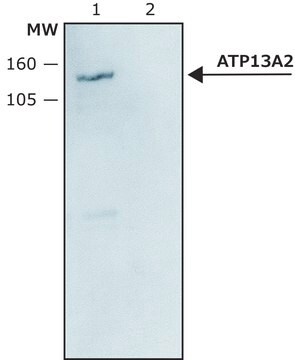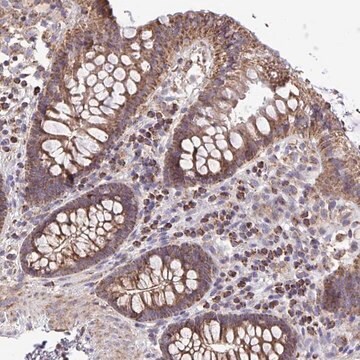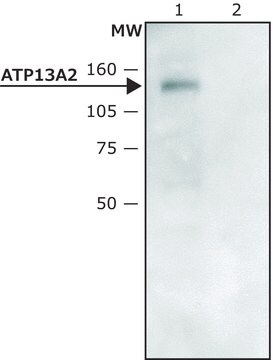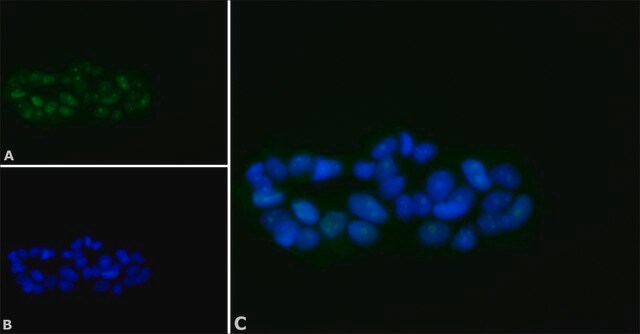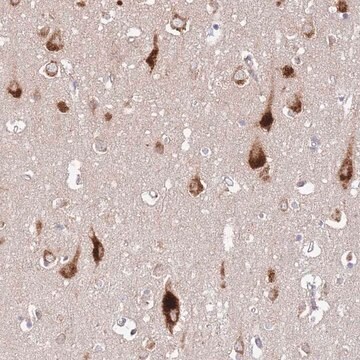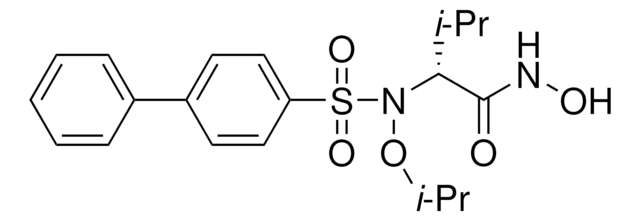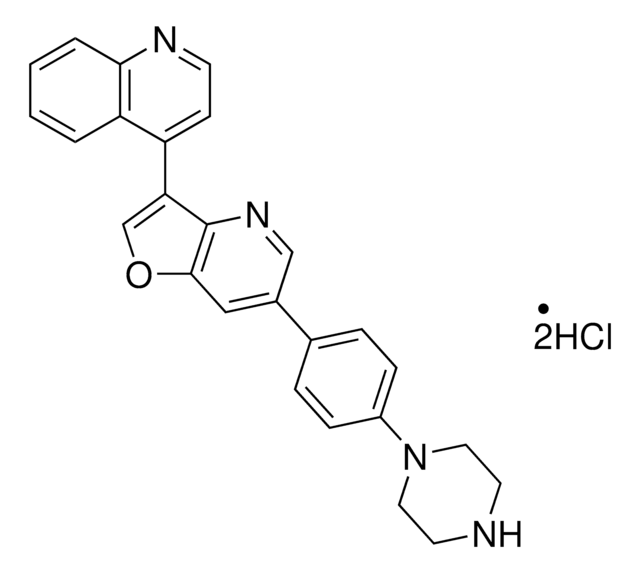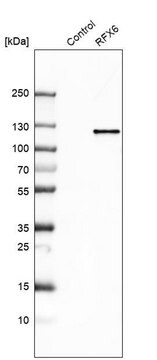추천 제품
생물학적 소스
rabbit
Quality Level
결합
unconjugated
항체 형태
affinity isolated antibody
항체 생산 유형
primary antibodies
클론
polyclonal
양식
buffered aqueous solution
분자량
antigen ~129 kDa
종 반응성
mouse, human
향상된 검증
recombinant expression
Learn more about Antibody Enhanced Validation
농도
~1.5 mg/mL
기술
western blot: 1-2 μg/mL using mouse brain extract (S1 fraction)
western blot: 2-4 μg/mL using extract of HEK-293T cells expressing human ATP13A2
UniProt 수납 번호
배송 상태
dry ice
저장 온도
−20°C
타겟 번역 후 변형
unmodified
유전자 정보
human ... ATP13A2(23400)
mouse ... Atp13a2(74772)
일반 설명
ATP13A2 is a member of the P5 family of ATPases which function in the transport of inorganic cations.
ATPase type 13 A2 (ATP13A2), also known as Parkinson′s disease 9 (PARK9), codes for P-type ATPase that is present on the lysosomal membrane with ten transmembrane domains.
애플리케이션
Anti-ATP13A2 (C-terminal) antibody produced in rabbit has also been used in immunohistochemistry.
Rabbit Anti-ATP13A2 (C-terminal) antibody has be used for immunofluorescence and western blotting assays.
생화학적/생리학적 작용
ATPase type 13A2 (ATP13A2) plays a vital role in regulation of mitochondrial bioenergetics by macroautophagy. Mutations in the ATP13A2 gene leads to the development of hereditary form of Parkinson associated with dementia, known as Kufor-Rakeb syndrome (KRS).
물리적 형태
Solution in 0.01 M phosphate buffered saline, pH 7.4, containing 15 mM sodium azide.
면책조항
Unless otherwise stated in our catalog or other company documentation accompanying the product(s), our products are intended for research use only and are not to be used for any other purpose, which includes but is not limited to, unauthorized commercial uses, in vitro diagnostic uses, ex vivo or in vivo therapeutic uses or any type of consumption or application to humans or animals.
적합한 제품을 찾을 수 없으신가요?
당사의 제품 선택기 도구.을(를) 시도해 보세요.
Storage Class Code
10 - Combustible liquids
Flash Point (°F)
Not applicable
Flash Point (°C)
Not applicable
개인 보호 장비
Eyeshields, Gloves, multi-purpose combination respirator cartridge (US)
Karen E Murphy et al.
Acta neuropathologica communications, 1, 11-11 (2013-11-21)
ATP13A2 (PARK9) loss of function mutations are a genetic cause of an early-onset form of Parkinson's disease (PD), with in vitro studies showing that ATP13A2 deficits lead to lysosomal and mitochondrial dysfunction and α-synuclein accumulation, while elevated ATP13A2 expression reduces
Aaron M Gusdon et al.
Neurobiology of disease, 45(3), 962-972 (2011-12-27)
Mitochondrial dysfunction and autophagy are centrally implicated in Parkinson's disease (PD). Mutations in ATP13A2, which encodes a lysosomal P-type ATPase of unknown function, cause a rare, autosomal recessive parkinsonian syndrome. Lysosomes are essential for autophagy, and autophagic clearance of dysfunctional
David Ramonet et al.
Human molecular genetics, 21(8), 1725-1743 (2011-12-22)
Mutations in the ATP13A2 gene (PARK9, OMIM 610513) cause autosomal recessive, juvenile-onset Kufor-Rakeb syndrome and early-onset parkinsonism. ATP13A2 is an uncharacterized protein belonging to the P(5)-type ATPase subfamily that is predicted to regulate the membrane transport of cations. The physiological
Jason P Covy et al.
Journal of neuroscience research, 90(12), 2306-2316 (2012-08-01)
Mutations in ATP13A2, which encodes a lysosomal P-type ATPase of unknown function, cause an autosomal recessive parkinsonian syndrome. With mammalian cells, we show that ATP13A2 expression protects against manganese and nickel toxicity, in addition to proteasomal, mitochondrial, and oxidative stress.
자사의 과학자팀은 생명 과학, 재료 과학, 화학 합성, 크로마토그래피, 분석 및 기타 많은 영역을 포함한 모든 과학 분야에 경험이 있습니다..
고객지원팀으로 연락바랍니다.
